Supplementary Cementitious Materials: Concrete Property Evolution
VerifiedAdded on 2022/04/26
|7
|2065
|35
Project
AI Summary
This research project investigates the evolution of mechanical properties of concrete when using supplementary cementitious materials (SCMs) such as Fly Ash and Silica Fume as partial replacements for cement. The study aims to determine the impact of varying percentages of these SCMs on the compressive strength and elastic modulus of normal strength concrete. The experimental design includes conducting laboratory tests like specific gravity, sieve analysis, bulk density, and water absorption tests on aggregates to inform mix design. Cylinders with different SCMs are casted and tested at various intervals (3, 7, 14, 28, and 56 days) to find the optimum compressive strength. The findings are compiled into comparison tables and graphs, analyzing the relationship between compressive strength and sample age, as well as elastic modulus and sample age, with a final stress-strain graph created for analysis. The research highlights the potential benefits of using SCMs, including cost reduction, conservation of natural resources, and improved waste management, while also acknowledging limitations related to plastic shrinkage cracking and delayed strength development if mix designs are not appropriately adjusted.
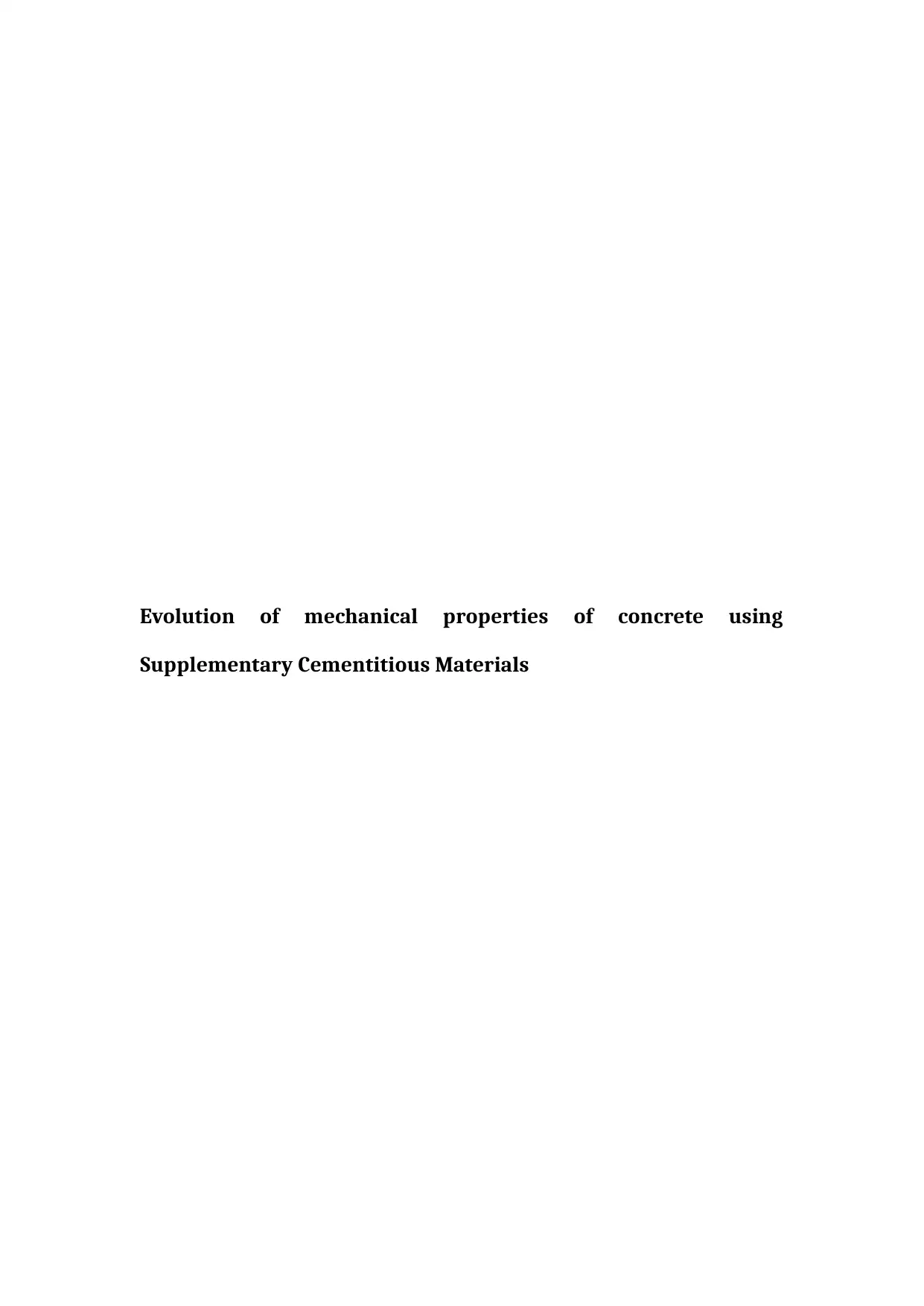
Evolution of mechanical properties of concrete using
Supplementary Cementitious Materials
Supplementary Cementitious Materials
Paraphrase This Document
Need a fresh take? Get an instant paraphrase of this document with our AI Paraphraser

Contents
1 Statement:.................................................................................................................................... 2
2 Abstract:....................................................................................................................................... 2
3 Introduction:............................................................................................................................... 2
3.1 Need of research:............................................................................................................. 2
3.2 Significance:....................................................................................................................... 2
4 Aim, Expected Outcomes and Research Questions.....................................................3
4.1 Benefits:............................................................................................................................... 3
5 Study Design/Approach......................................................................................................... 4
6 Experimental.............................................................................................................................. 4
6.1 Materials.............................................................................................................................. 4
6.2 Apparatus:........................................................................................................................... 4
6.3 Methods:.............................................................................................................................. 4
6.4 Data Analyses Methods:................................................................................................ 5
7 Limitations................................................................................................................................... 5
8 Timeline........................................................................................................................................ 5
9 References:.................................................................................................................................. 6
1 Statement:.................................................................................................................................... 2
2 Abstract:....................................................................................................................................... 2
3 Introduction:............................................................................................................................... 2
3.1 Need of research:............................................................................................................. 2
3.2 Significance:....................................................................................................................... 2
4 Aim, Expected Outcomes and Research Questions.....................................................3
4.1 Benefits:............................................................................................................................... 3
5 Study Design/Approach......................................................................................................... 4
6 Experimental.............................................................................................................................. 4
6.1 Materials.............................................................................................................................. 4
6.2 Apparatus:........................................................................................................................... 4
6.3 Methods:.............................................................................................................................. 4
6.4 Data Analyses Methods:................................................................................................ 5
7 Limitations................................................................................................................................... 5
8 Timeline........................................................................................................................................ 5
9 References:.................................................................................................................................. 6
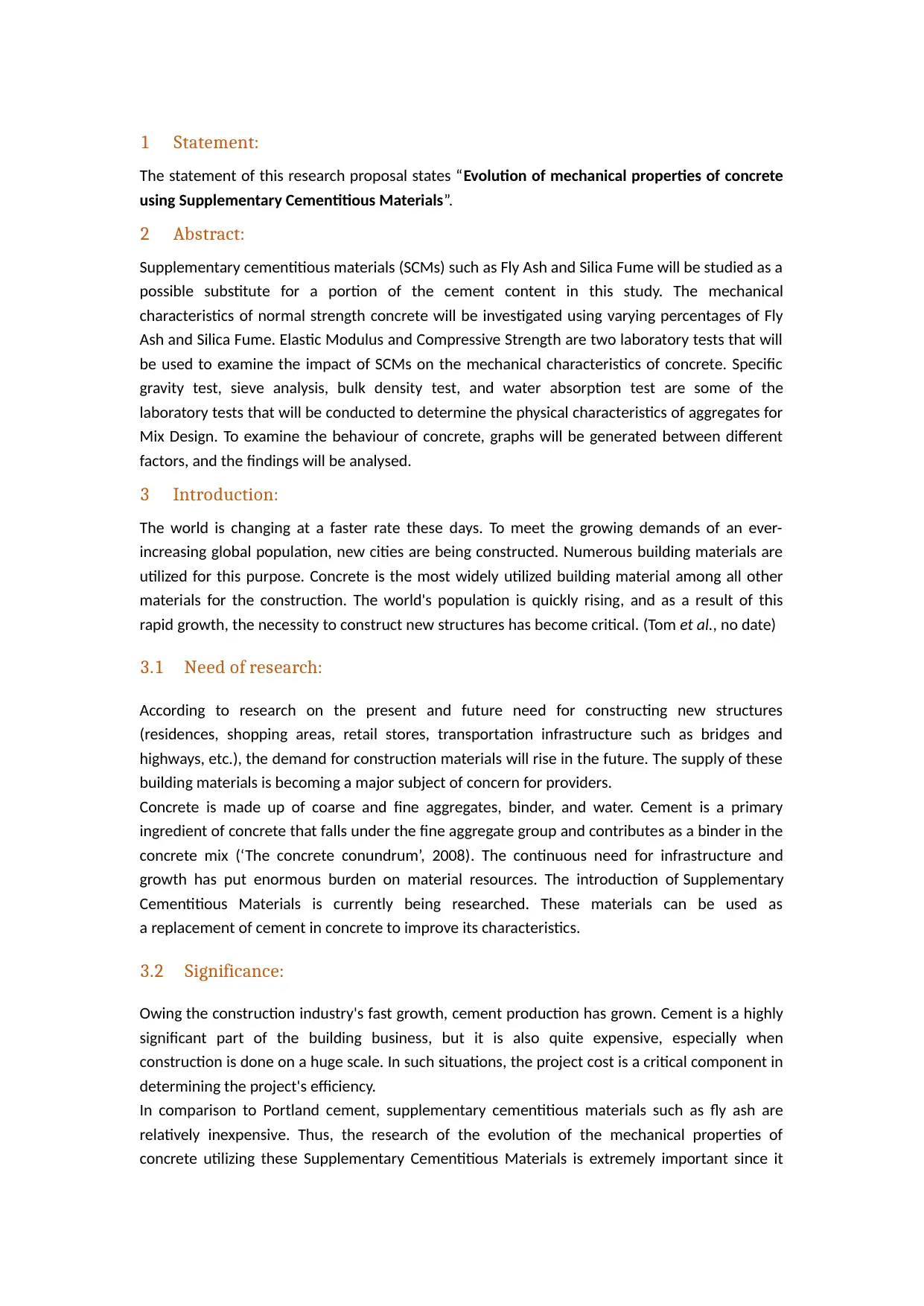
1 Statement:
The statement of this research proposal states “Evolution of mechanical properties of concrete
using Supplementary Cementitious Materials”.
2 Abstract:
Supplementary cementitious materials (SCMs) such as Fly Ash and Silica Fume will be studied as a
possible substitute for a portion of the cement content in this study. The mechanical
characteristics of normal strength concrete will be investigated using varying percentages of Fly
Ash and Silica Fume. Elastic Modulus and Compressive Strength are two laboratory tests that will
be used to examine the impact of SCMs on the mechanical characteristics of concrete. Specific
gravity test, sieve analysis, bulk density test, and water absorption test are some of the
laboratory tests that will be conducted to determine the physical characteristics of aggregates for
Mix Design. To examine the behaviour of concrete, graphs will be generated between different
factors, and the findings will be analysed.
3 Introduction:
The world is changing at a faster rate these days. To meet the growing demands of an ever-
increasing global population, new cities are being constructed. Numerous building materials are
utilized for this purpose. Concrete is the most widely utilized building material among all other
materials for the construction. The world's population is quickly rising, and as a result of this
rapid growth, the necessity to construct new structures has become critical. (Tom et al., no date)
3.1 Need of research:
According to research on the present and future need for constructing new structures
(residences, shopping areas, retail stores, transportation infrastructure such as bridges and
highways, etc.), the demand for construction materials will rise in the future. The supply of these
building materials is becoming a major subject of concern for providers.
Concrete is made up of coarse and fine aggregates, binder, and water. Cement is a primary
ingredient of concrete that falls under the fine aggregate group and contributes as a binder in the
concrete mix (‘The concrete conundrum’, 2008). The continuous need for infrastructure and
growth has put enormous burden on material resources. The introduction of Supplementary
Cementitious Materials is currently being researched. These materials can be used as
a replacement of cement in concrete to improve its characteristics.
3.2 Significance:
Owing the construction industry's fast growth, cement production has grown. Cement is a highly
significant part of the building business, but it is also quite expensive, especially when
construction is done on a huge scale. In such situations, the project cost is a critical component in
determining the project's efficiency.
In comparison to Portland cement, supplementary cementitious materials such as fly ash are
relatively inexpensive. Thus, the research of the evolution of the mechanical properties of
concrete utilizing these Supplementary Cementitious Materials is extremely important since it
The statement of this research proposal states “Evolution of mechanical properties of concrete
using Supplementary Cementitious Materials”.
2 Abstract:
Supplementary cementitious materials (SCMs) such as Fly Ash and Silica Fume will be studied as a
possible substitute for a portion of the cement content in this study. The mechanical
characteristics of normal strength concrete will be investigated using varying percentages of Fly
Ash and Silica Fume. Elastic Modulus and Compressive Strength are two laboratory tests that will
be used to examine the impact of SCMs on the mechanical characteristics of concrete. Specific
gravity test, sieve analysis, bulk density test, and water absorption test are some of the
laboratory tests that will be conducted to determine the physical characteristics of aggregates for
Mix Design. To examine the behaviour of concrete, graphs will be generated between different
factors, and the findings will be analysed.
3 Introduction:
The world is changing at a faster rate these days. To meet the growing demands of an ever-
increasing global population, new cities are being constructed. Numerous building materials are
utilized for this purpose. Concrete is the most widely utilized building material among all other
materials for the construction. The world's population is quickly rising, and as a result of this
rapid growth, the necessity to construct new structures has become critical. (Tom et al., no date)
3.1 Need of research:
According to research on the present and future need for constructing new structures
(residences, shopping areas, retail stores, transportation infrastructure such as bridges and
highways, etc.), the demand for construction materials will rise in the future. The supply of these
building materials is becoming a major subject of concern for providers.
Concrete is made up of coarse and fine aggregates, binder, and water. Cement is a primary
ingredient of concrete that falls under the fine aggregate group and contributes as a binder in the
concrete mix (‘The concrete conundrum’, 2008). The continuous need for infrastructure and
growth has put enormous burden on material resources. The introduction of Supplementary
Cementitious Materials is currently being researched. These materials can be used as
a replacement of cement in concrete to improve its characteristics.
3.2 Significance:
Owing the construction industry's fast growth, cement production has grown. Cement is a highly
significant part of the building business, but it is also quite expensive, especially when
construction is done on a huge scale. In such situations, the project cost is a critical component in
determining the project's efficiency.
In comparison to Portland cement, supplementary cementitious materials such as fly ash are
relatively inexpensive. Thus, the research of the evolution of the mechanical properties of
concrete utilizing these Supplementary Cementitious Materials is extremely important since it
⊘ This is a preview!⊘
Do you want full access?
Subscribe today to unlock all pages.

Trusted by 1+ million students worldwide
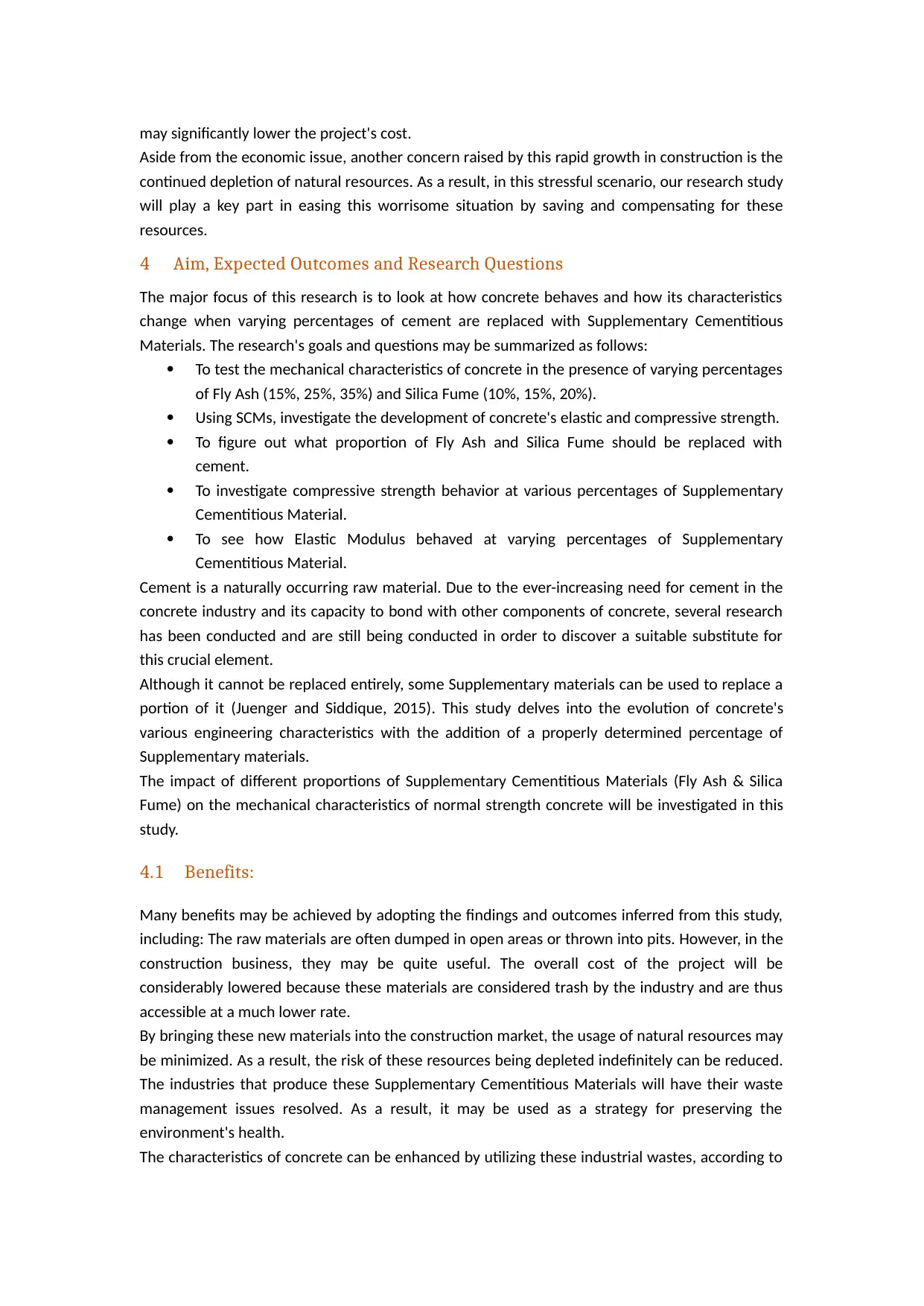
may significantly lower the project's cost.
Aside from the economic issue, another concern raised by this rapid growth in construction is the
continued depletion of natural resources. As a result, in this stressful scenario, our research study
will play a key part in easing this worrisome situation by saving and compensating for these
resources.
4 Aim, Expected Outcomes and Research Questions
The major focus of this research is to look at how concrete behaves and how its characteristics
change when varying percentages of cement are replaced with Supplementary Cementitious
Materials. The research's goals and questions may be summarized as follows:
To test the mechanical characteristics of concrete in the presence of varying percentages
of Fly Ash (15%, 25%, 35%) and Silica Fume (10%, 15%, 20%).
Using SCMs, investigate the development of concrete's elastic and compressive strength.
To figure out what proportion of Fly Ash and Silica Fume should be replaced with
cement.
To investigate compressive strength behavior at various percentages of Supplementary
Cementitious Material.
To see how Elastic Modulus behaved at varying percentages of Supplementary
Cementitious Material.
Cement is a naturally occurring raw material. Due to the ever-increasing need for cement in the
concrete industry and its capacity to bond with other components of concrete, several research
has been conducted and are still being conducted in order to discover a suitable substitute for
this crucial element.
Although it cannot be replaced entirely, some Supplementary materials can be used to replace a
portion of it (Juenger and Siddique, 2015). This study delves into the evolution of concrete's
various engineering characteristics with the addition of a properly determined percentage of
Supplementary materials.
The impact of different proportions of Supplementary Cementitious Materials (Fly Ash & Silica
Fume) on the mechanical characteristics of normal strength concrete will be investigated in this
study.
4.1 Benefits:
Many benefits may be achieved by adopting the findings and outcomes inferred from this study,
including: The raw materials are often dumped in open areas or thrown into pits. However, in the
construction business, they may be quite useful. The overall cost of the project will be
considerably lowered because these materials are considered trash by the industry and are thus
accessible at a much lower rate.
By bringing these new materials into the construction market, the usage of natural resources may
be minimized. As a result, the risk of these resources being depleted indefinitely can be reduced.
The industries that produce these Supplementary Cementitious Materials will have their waste
management issues resolved. As a result, it may be used as a strategy for preserving the
environment's health.
The characteristics of concrete can be enhanced by utilizing these industrial wastes, according to
Aside from the economic issue, another concern raised by this rapid growth in construction is the
continued depletion of natural resources. As a result, in this stressful scenario, our research study
will play a key part in easing this worrisome situation by saving and compensating for these
resources.
4 Aim, Expected Outcomes and Research Questions
The major focus of this research is to look at how concrete behaves and how its characteristics
change when varying percentages of cement are replaced with Supplementary Cementitious
Materials. The research's goals and questions may be summarized as follows:
To test the mechanical characteristics of concrete in the presence of varying percentages
of Fly Ash (15%, 25%, 35%) and Silica Fume (10%, 15%, 20%).
Using SCMs, investigate the development of concrete's elastic and compressive strength.
To figure out what proportion of Fly Ash and Silica Fume should be replaced with
cement.
To investigate compressive strength behavior at various percentages of Supplementary
Cementitious Material.
To see how Elastic Modulus behaved at varying percentages of Supplementary
Cementitious Material.
Cement is a naturally occurring raw material. Due to the ever-increasing need for cement in the
concrete industry and its capacity to bond with other components of concrete, several research
has been conducted and are still being conducted in order to discover a suitable substitute for
this crucial element.
Although it cannot be replaced entirely, some Supplementary materials can be used to replace a
portion of it (Juenger and Siddique, 2015). This study delves into the evolution of concrete's
various engineering characteristics with the addition of a properly determined percentage of
Supplementary materials.
The impact of different proportions of Supplementary Cementitious Materials (Fly Ash & Silica
Fume) on the mechanical characteristics of normal strength concrete will be investigated in this
study.
4.1 Benefits:
Many benefits may be achieved by adopting the findings and outcomes inferred from this study,
including: The raw materials are often dumped in open areas or thrown into pits. However, in the
construction business, they may be quite useful. The overall cost of the project will be
considerably lowered because these materials are considered trash by the industry and are thus
accessible at a much lower rate.
By bringing these new materials into the construction market, the usage of natural resources may
be minimized. As a result, the risk of these resources being depleted indefinitely can be reduced.
The industries that produce these Supplementary Cementitious Materials will have their waste
management issues resolved. As a result, it may be used as a strategy for preserving the
environment's health.
The characteristics of concrete can be enhanced by utilizing these industrial wastes, according to
Paraphrase This Document
Need a fresh take? Get an instant paraphrase of this document with our AI Paraphraser
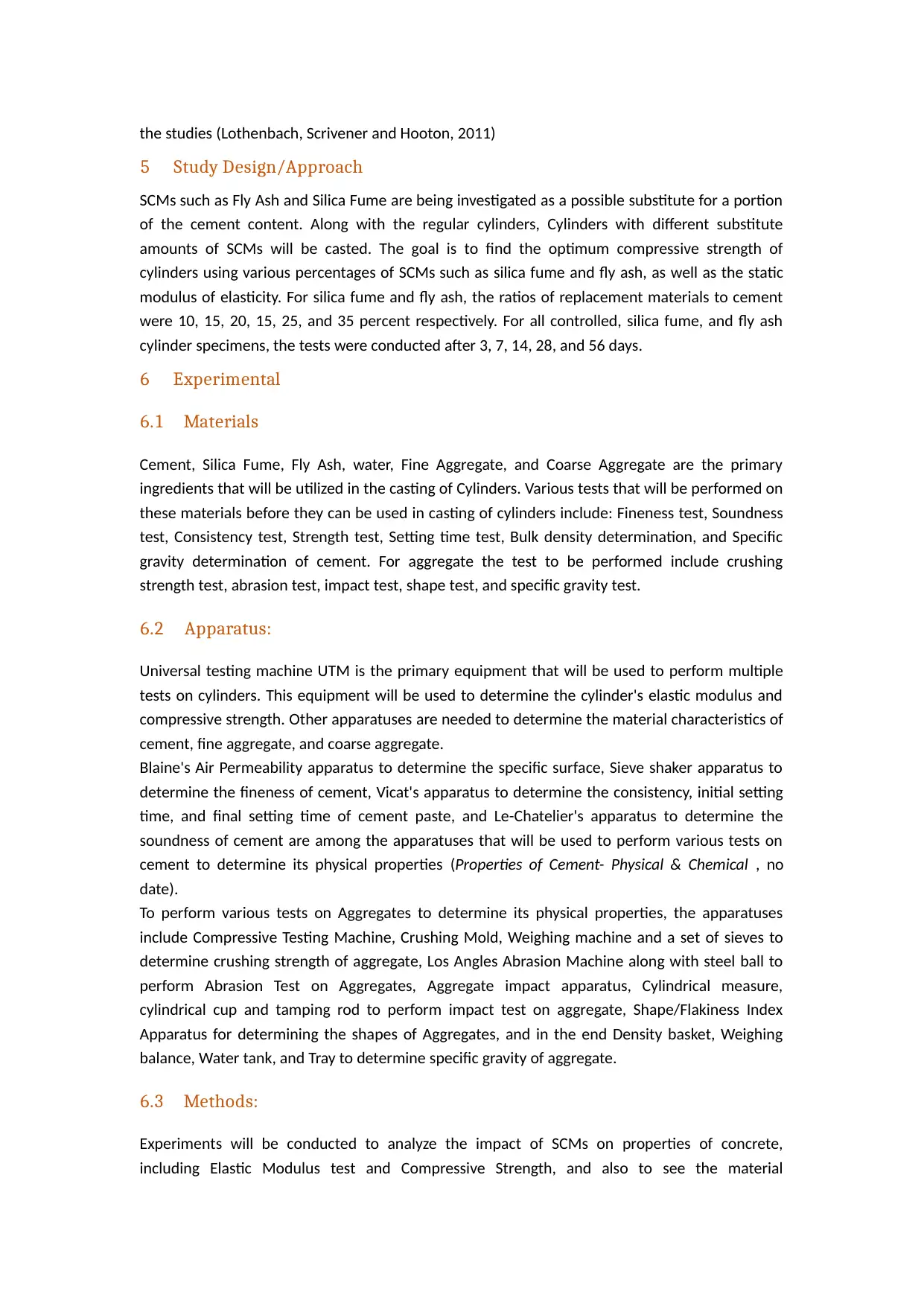
the studies (Lothenbach, Scrivener and Hooton, 2011)
5 Study Design/Approach
SCMs such as Fly Ash and Silica Fume are being investigated as a possible substitute for a portion
of the cement content. Along with the regular cylinders, Cylinders with different substitute
amounts of SCMs will be casted. The goal is to find the optimum compressive strength of
cylinders using various percentages of SCMs such as silica fume and fly ash, as well as the static
modulus of elasticity. For silica fume and fly ash, the ratios of replacement materials to cement
were 10, 15, 20, 15, 25, and 35 percent respectively. For all controlled, silica fume, and fly ash
cylinder specimens, the tests were conducted after 3, 7, 14, 28, and 56 days.
6 Experimental
6.1 Materials
Cement, Silica Fume, Fly Ash, water, Fine Aggregate, and Coarse Aggregate are the primary
ingredients that will be utilized in the casting of Cylinders. Various tests that will be performed on
these materials before they can be used in casting of cylinders include: Fineness test, Soundness
test, Consistency test, Strength test, Setting time test, Bulk density determination, and Specific
gravity determination of cement. For aggregate the test to be performed include crushing
strength test, abrasion test, impact test, shape test, and specific gravity test.
6.2 Apparatus:
Universal testing machine UTM is the primary equipment that will be used to perform multiple
tests on cylinders. This equipment will be used to determine the cylinder's elastic modulus and
compressive strength. Other apparatuses are needed to determine the material characteristics of
cement, fine aggregate, and coarse aggregate.
Blaine's Air Permeability apparatus to determine the specific surface, Sieve shaker apparatus to
determine the fineness of cement, Vicat's apparatus to determine the consistency, initial setting
time, and final setting time of cement paste, and Le-Chatelier's apparatus to determine the
soundness of cement are among the apparatuses that will be used to perform various tests on
cement to determine its physical properties (Properties of Cement- Physical & Chemical , no
date).
To perform various tests on Aggregates to determine its physical properties, the apparatuses
include Compressive Testing Machine, Crushing Mold, Weighing machine and a set of sieves to
determine crushing strength of aggregate, Los Angles Abrasion Machine along with steel ball to
perform Abrasion Test on Aggregates, Aggregate impact apparatus, Cylindrical measure,
cylindrical cup and tamping rod to perform impact test on aggregate, Shape/Flakiness Index
Apparatus for determining the shapes of Aggregates, and in the end Density basket, Weighing
balance, Water tank, and Tray to determine specific gravity of aggregate.
6.3 Methods:
Experiments will be conducted to analyze the impact of SCMs on properties of concrete,
including Elastic Modulus test and Compressive Strength, and also to see the material
5 Study Design/Approach
SCMs such as Fly Ash and Silica Fume are being investigated as a possible substitute for a portion
of the cement content. Along with the regular cylinders, Cylinders with different substitute
amounts of SCMs will be casted. The goal is to find the optimum compressive strength of
cylinders using various percentages of SCMs such as silica fume and fly ash, as well as the static
modulus of elasticity. For silica fume and fly ash, the ratios of replacement materials to cement
were 10, 15, 20, 15, 25, and 35 percent respectively. For all controlled, silica fume, and fly ash
cylinder specimens, the tests were conducted after 3, 7, 14, 28, and 56 days.
6 Experimental
6.1 Materials
Cement, Silica Fume, Fly Ash, water, Fine Aggregate, and Coarse Aggregate are the primary
ingredients that will be utilized in the casting of Cylinders. Various tests that will be performed on
these materials before they can be used in casting of cylinders include: Fineness test, Soundness
test, Consistency test, Strength test, Setting time test, Bulk density determination, and Specific
gravity determination of cement. For aggregate the test to be performed include crushing
strength test, abrasion test, impact test, shape test, and specific gravity test.
6.2 Apparatus:
Universal testing machine UTM is the primary equipment that will be used to perform multiple
tests on cylinders. This equipment will be used to determine the cylinder's elastic modulus and
compressive strength. Other apparatuses are needed to determine the material characteristics of
cement, fine aggregate, and coarse aggregate.
Blaine's Air Permeability apparatus to determine the specific surface, Sieve shaker apparatus to
determine the fineness of cement, Vicat's apparatus to determine the consistency, initial setting
time, and final setting time of cement paste, and Le-Chatelier's apparatus to determine the
soundness of cement are among the apparatuses that will be used to perform various tests on
cement to determine its physical properties (Properties of Cement- Physical & Chemical , no
date).
To perform various tests on Aggregates to determine its physical properties, the apparatuses
include Compressive Testing Machine, Crushing Mold, Weighing machine and a set of sieves to
determine crushing strength of aggregate, Los Angles Abrasion Machine along with steel ball to
perform Abrasion Test on Aggregates, Aggregate impact apparatus, Cylindrical measure,
cylindrical cup and tamping rod to perform impact test on aggregate, Shape/Flakiness Index
Apparatus for determining the shapes of Aggregates, and in the end Density basket, Weighing
balance, Water tank, and Tray to determine specific gravity of aggregate.
6.3 Methods:
Experiments will be conducted to analyze the impact of SCMs on properties of concrete,
including Elastic Modulus test and Compressive Strength, and also to see the material
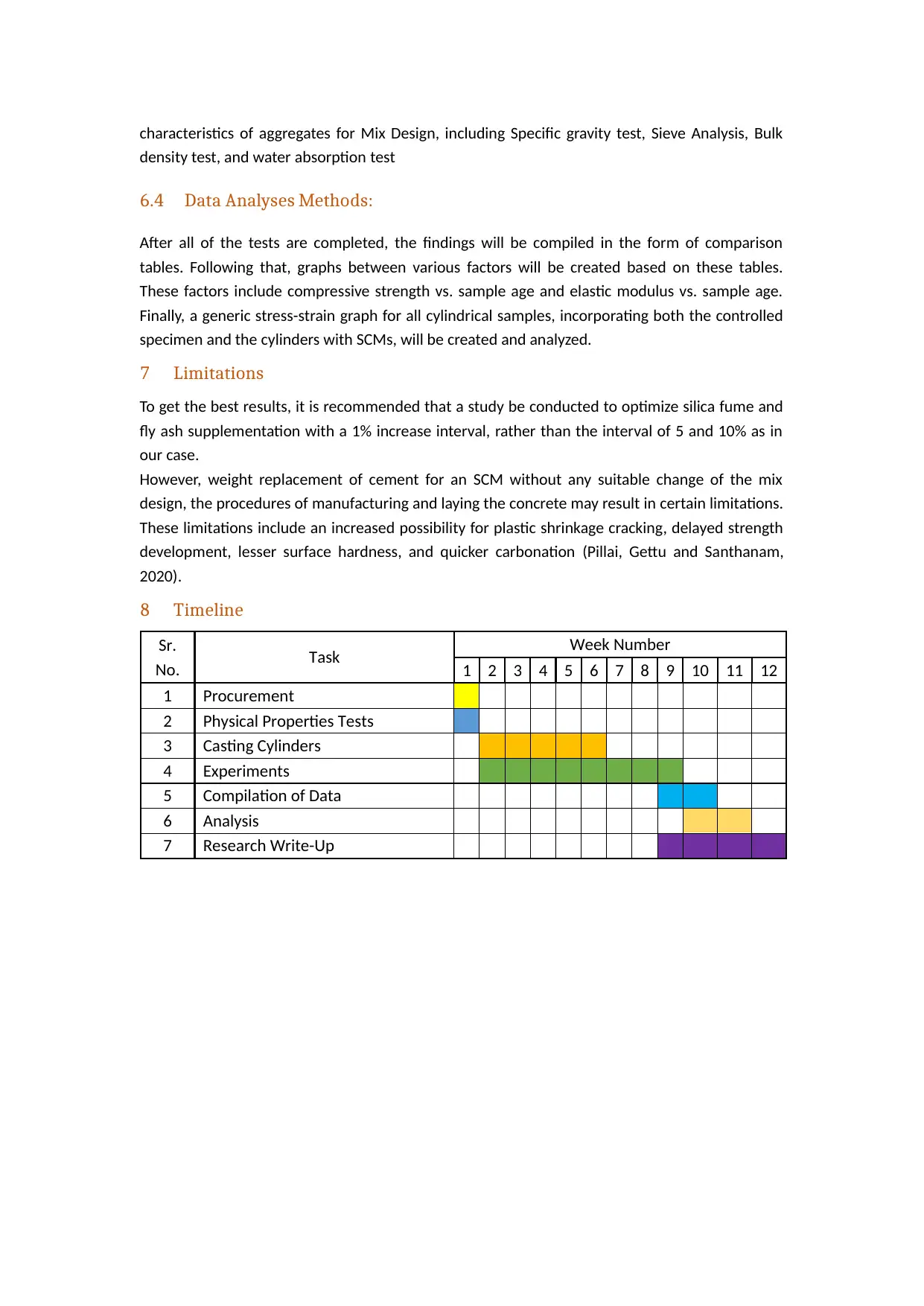
characteristics of aggregates for Mix Design, including Specific gravity test, Sieve Analysis, Bulk
density test, and water absorption test
6.4 Data Analyses Methods:
After all of the tests are completed, the findings will be compiled in the form of comparison
tables. Following that, graphs between various factors will be created based on these tables.
These factors include compressive strength vs. sample age and elastic modulus vs. sample age.
Finally, a generic stress-strain graph for all cylindrical samples, incorporating both the controlled
specimen and the cylinders with SCMs, will be created and analyzed.
7 Limitations
To get the best results, it is recommended that a study be conducted to optimize silica fume and
fly ash supplementation with a 1% increase interval, rather than the interval of 5 and 10% as in
our case.
However, weight replacement of cement for an SCM without any suitable change of the mix
design, the procedures of manufacturing and laying the concrete may result in certain limitations.
These limitations include an increased possibility for plastic shrinkage cracking, delayed strength
development, lesser surface hardness, and quicker carbonation (Pillai, Gettu and Santhanam,
2020).
8 Timeline
Sr.
No. Task Week Number
1 2 3 4 5 6 7 8 9 10 11 12
1 Procurement
2 Physical Properties Tests
3 Casting Cylinders
4 Experiments
5 Compilation of Data
6 Analysis
7 Research Write-Up
density test, and water absorption test
6.4 Data Analyses Methods:
After all of the tests are completed, the findings will be compiled in the form of comparison
tables. Following that, graphs between various factors will be created based on these tables.
These factors include compressive strength vs. sample age and elastic modulus vs. sample age.
Finally, a generic stress-strain graph for all cylindrical samples, incorporating both the controlled
specimen and the cylinders with SCMs, will be created and analyzed.
7 Limitations
To get the best results, it is recommended that a study be conducted to optimize silica fume and
fly ash supplementation with a 1% increase interval, rather than the interval of 5 and 10% as in
our case.
However, weight replacement of cement for an SCM without any suitable change of the mix
design, the procedures of manufacturing and laying the concrete may result in certain limitations.
These limitations include an increased possibility for plastic shrinkage cracking, delayed strength
development, lesser surface hardness, and quicker carbonation (Pillai, Gettu and Santhanam,
2020).
8 Timeline
Sr.
No. Task Week Number
1 2 3 4 5 6 7 8 9 10 11 12
1 Procurement
2 Physical Properties Tests
3 Casting Cylinders
4 Experiments
5 Compilation of Data
6 Analysis
7 Research Write-Up
⊘ This is a preview!⊘
Do you want full access?
Subscribe today to unlock all pages.

Trusted by 1+ million students worldwide

9 References:
Juenger, M. C. G. and Siddique, R. (2015) ‘Recent advances in understanding the role of
supplementary cementitious materials in concrete’, Cement and Concrete Research, 78, pp. 71–80.
doi: 10.1016/J.CEMCONRES.2015.03.018.
Lothenbach, B., Scrivener, K. and Hooton, R. D. (2011) ‘Supplementary cementitious materials’,
Cement and Concrete Research, 41(12), pp. 1244–1256. doi: 10.1016/J.CEMCONRES.2010.12.001.
Pillai, R. G., Gettu, R. and Santhanam, M. (2020) ‘Use of supplementary cementitious materials (SCMs)
in reinforced concrete systems – Benefits and limitations’, Revista ALCONPAT, 10(2), pp. 147–164. doi:
10.21041/RA.V10I2.477.
Properties of Cement- Physical & Chemical (no date). Available at: https://civiltoday.com/civil-
engineering-materials/cement/111-properties-of-cement-physical-chemical-properties (Accessed: 7
October 2021).
‘The concrete conundrum’ (2008). Available at: www.chemistryworld.org (Accessed: 5 October 2021).
Tom, B. et al. (no date) ‘Rapid urban expansion and the impact on construction materials supply’.
Juenger, M. C. G. and Siddique, R. (2015) ‘Recent advances in understanding the role of
supplementary cementitious materials in concrete’, Cement and Concrete Research, 78, pp. 71–80.
doi: 10.1016/J.CEMCONRES.2015.03.018.
Lothenbach, B., Scrivener, K. and Hooton, R. D. (2011) ‘Supplementary cementitious materials’,
Cement and Concrete Research, 41(12), pp. 1244–1256. doi: 10.1016/J.CEMCONRES.2010.12.001.
Pillai, R. G., Gettu, R. and Santhanam, M. (2020) ‘Use of supplementary cementitious materials (SCMs)
in reinforced concrete systems – Benefits and limitations’, Revista ALCONPAT, 10(2), pp. 147–164. doi:
10.21041/RA.V10I2.477.
Properties of Cement- Physical & Chemical (no date). Available at: https://civiltoday.com/civil-
engineering-materials/cement/111-properties-of-cement-physical-chemical-properties (Accessed: 7
October 2021).
‘The concrete conundrum’ (2008). Available at: www.chemistryworld.org (Accessed: 5 October 2021).
Tom, B. et al. (no date) ‘Rapid urban expansion and the impact on construction materials supply’.
1 out of 7
Related Documents
Your All-in-One AI-Powered Toolkit for Academic Success.
+13062052269
info@desklib.com
Available 24*7 on WhatsApp / Email
![[object Object]](/_next/static/media/star-bottom.7253800d.svg)
Unlock your academic potential
Copyright © 2020–2026 A2Z Services. All Rights Reserved. Developed and managed by ZUCOL.





